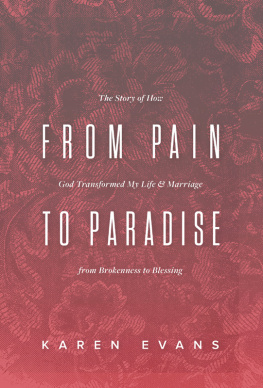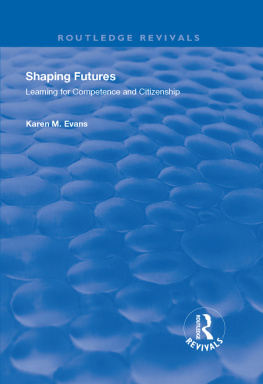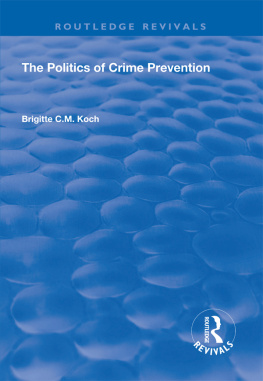Karen Evanss latest book, Community and the Problem of Crime, represents an excellent analytical and empirically grounded guide to this highly contested and massively important area of social scientific inquiry. This challenging yet accessible monograph will become an invaluable must-have text for students of sociological criminology in particular. Evans makes significant contribution to our cumulative sociological knowledge of the crimecommunity nexus.
Gordon Hughes, Chair in Criminology, School of Social Sciences, Cardiff University, UK
The concept community is much used and abused in studies of crime, disorder and crime prevention. The language of community is frequently deployed as cause, location, symptom and solution for all manner of social problems. Fortunately, at last there is a book which brings a splendid, constructively critical, perspective to bear on this many-faceted phenomenon, even engaging with the diverse and contrary tendencies of real communities marginalisation, stigmatisation, privatisation, securitisation and militarisation as they reshape the social contexts through which we move/in which we live. A refreshing and original read.
Peter Squires, Professor of Criminology & Public Policy, University of Brighton, UK
This terrific book provides an exploration of the paradoxes and contradictions of community as these relate to crime and social justice. It demonstrates how community is seen to be both a source of social problems and the solution to it, and how it is strategically applied in ways that incorporate and/or marginalise specific population groups. Providing a theoretically informed analysis of concrete cases, trends and issues, the book makes a wonderful contribution to critical appraisals of the dynamics of contemporary society. A vital resource.
Rob White, Professor of Criminology, University of Tasmania, Australia
COMMUNITY AND THE PROBLEM OF CRIME
The relationship between crime and community has a long history in criminological thought, from the early notion of the criminogenic community developed by the Chicago sociologists through to various crime prevention models in research and policy. This book offers a useful theoretical overview of key approaches to the subject of crime and community and considers the ways in which these have been applied in more practical settings.
Written by an expert in the field and drawing on a range of international case studies from Europe, North America, Australia and Asia, this book explores both why and how crime and community have been linked and the implications of their relationship within criminology and crime prevention policy. Topics covered in the book include:
the different crime prevention paradigms which have been utilised in the fight against crime,
the turn to community in crime prevention policy, which took place during the 1980s in the UK and US and its subsequent development,
the particular theoretical and ideological underpinnings to crime prevention work in and with different communities,
the significance and impact of fear of crime on crime prevention policy,
different institutional responses to working with community in crime prevention and community safety,
the ways in which the experience of the UK and US have been translated into the European context,
a comparison between traditional Western responses to the growing interest in restorative and community-based approaches in other regions.
This book offers essential reading for students taking courses on crime and community, crime prevention, and community safety and community corrections.
Karen Evans is a senior lecturer at the Department of Sociology, Social Policy and Criminology at the University of Liverpool, where she has been employed since 1999. Immediately prior to this lecturing post she was Community Safety Co-ordinator working for the Moss Side and Hulme Partnership in Manchester, UK. With a first degree in Economics and Politics and an employment history, which involved working with the homeless and as a welfare rights advisor, Karen was a somewhat reluctant criminologist. Her research into urban transformations alongside the late Ian Taylor in the early 1990s led her into research into experiences of crime and victimisation in various cities in the Northwest of England, collaborating with Sandra Walklate and others in Liverpool. Karens work since that time has focused, although not exclusively, around communities in excluded neighbourhoods and their responses to marginalisation and deprivation. She has taught the module Community and the Problem of Crime in Liverpool for the last ten years.
First published 2016
by Routledge
2 Park Square, Milton Park, Abingdon, Oxon, OX14 4RN
and by Routledge
711 Third Avenue, New York, NY 10017
Routledge is an imprint of the Taylor & Francis Group, an informa business
2016 Karen Evans
The right of Karen Evans to be identified as author of this work has been asserted by her in accordance with sections 77 and 78 of the Copyright, Designs and Patents Act 1988.
All rights reserved. No part of this book may be reprinted or reproduced or utilised in any form or by any electronic, mechanical, or other means, now known or hereafter invented, including photocopying and recording, or in any information storage or retrieval system, without permission in writing from the publishers.
British Library Cataloguing in Publication Data
A catalogue record for this book is available from the British Library
Library of Congress Cataloging-in-Publication Data
Evans, Karen,
Community and the problem of crime / Karen Evans.
pages cm
1. CrimeSociological aspects. 2. Communities. 3. Sociology, Urban.
4. Community policing. 5. Crime prevention. I. Title.
HV6025.E8155 2015
364.25dc23 2014040816
ISBN: 978-0-415-74855-1 (hbk)
ISBN: 978-1-315-79654-3 (ebk)
Typeset in Bembo
by codeMantra
To VK and Alan
This book arises out of a module Community and the Problem of Crime which I designed in 2003 and have been leading at the University of Liverpool in the Department of Sociology, Social Policy and Criminology for the last decade. For a number of years I have shared the teaching of this module with other experts in their field who are based in my department. I would like to acknowledge the significant contribution they have made to my understanding of the subject. In particular, I would like to thank Lynn Hancock for her sustained contribution to the module, for her tireless enthusiasm for teaching and for sharing her expertise in this area.
This book has been written at a particularly difficult period of my life during which I have lost a number of people who have been very important to me and who have helped to develop my confidence and abilities. To those who remain and who have supported me throughout this time I give my thanks to Dave in particular who has had his own troubles to bear at this time but who has remained a fantastic source of strength to me. I must also thank my good friend Ivor Smith for inspiring me with his enthusiasm for my subject and his love of the work of John Clare and Andrew Davies. Thanks also to my copy editor, no other than my mother Barbara Evans, who checked my references as I packed her house into numerous boxes. If any references or indeed tableware are missing or broken, then I take full responsibility.
I would also like to acknowledge the part Microsoft has played in the production of this book. Without the global dominance of this corporation and the contribution of its Windows 8 software writers in particular, the writing of this book would have been made so much easier.







